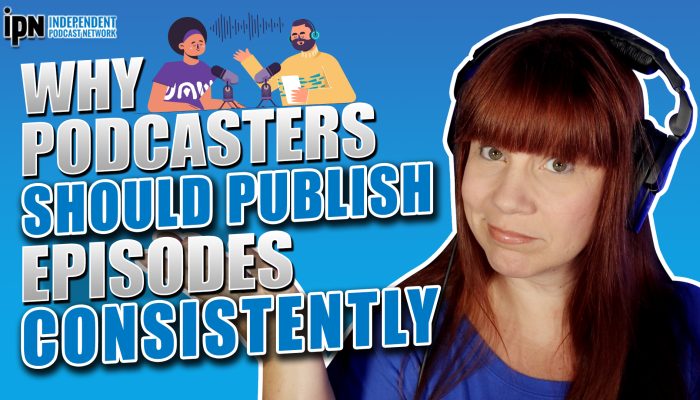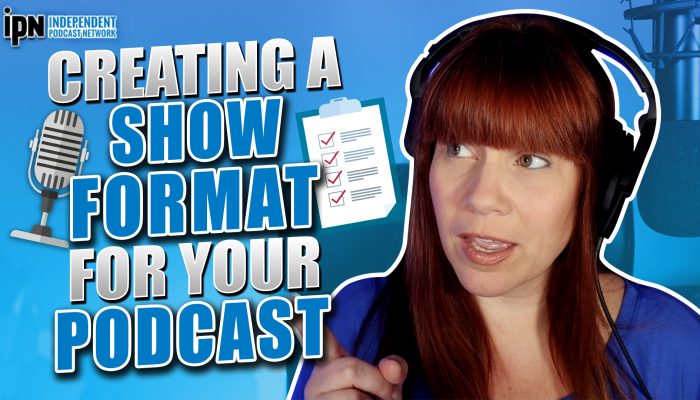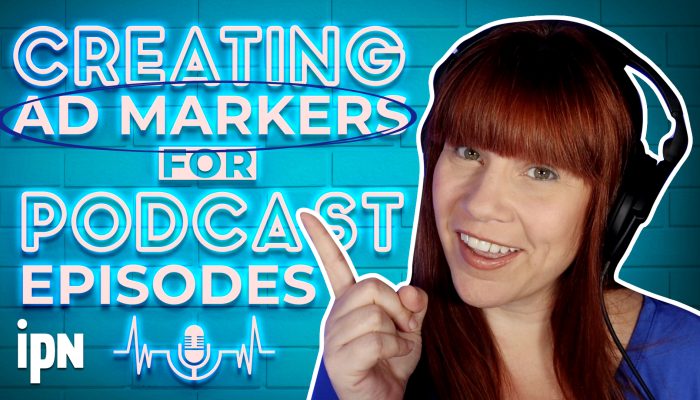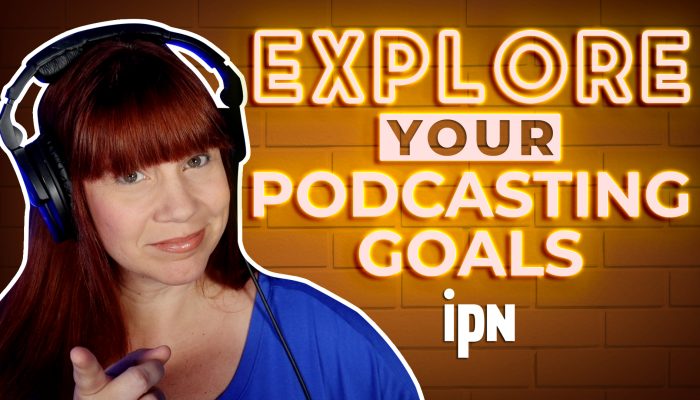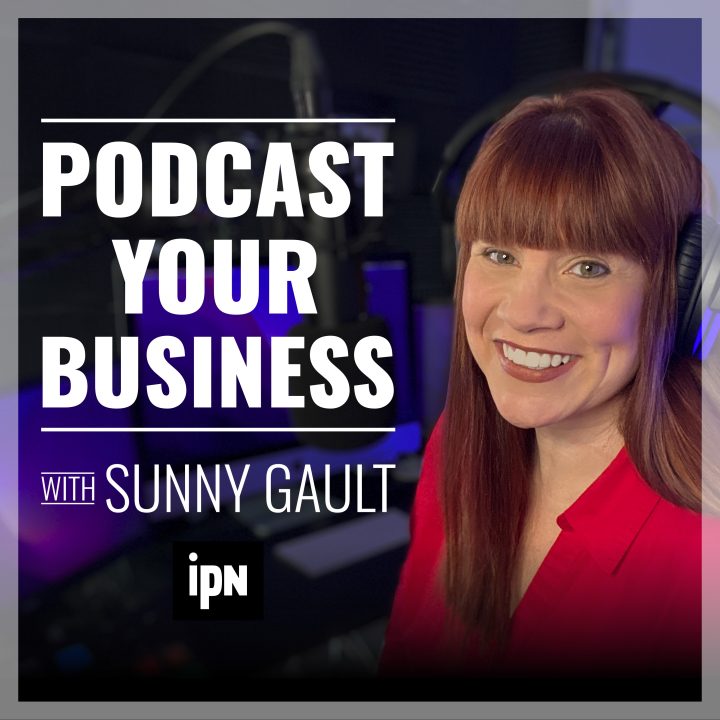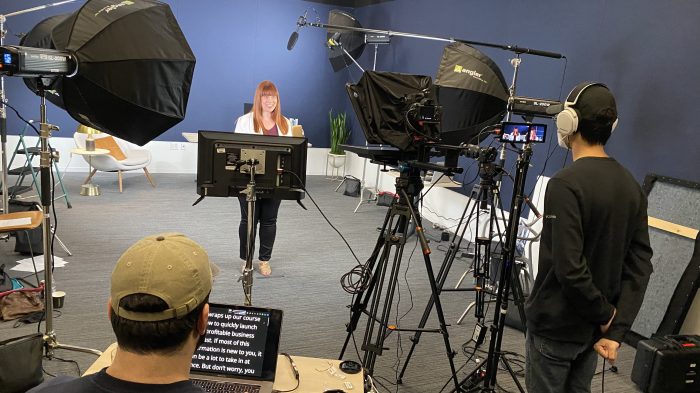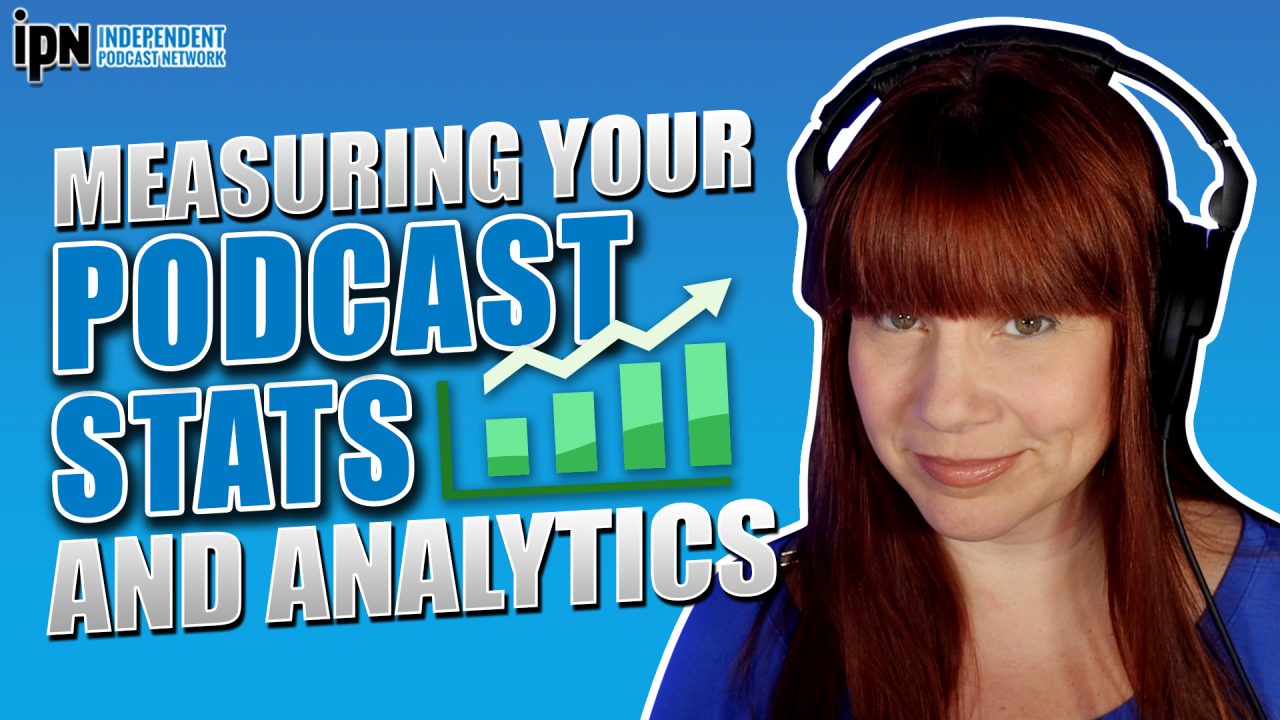
what metrics really matter and why?
Even if you’re not a numbers person, knowing your podcast stats and analytics is an important step in your production process. If you know who is listening and what they’re listening to then you can create more content that they like and potentially grow your podcast audience. And if you’re planning to work with partners or advertisers, they’ll also want to know how many people are listening and how often. So, how do you know which metrics to track and how often? Today we’re talking about measuring your podcast stats and analytics.
In today’s episode, we’re going to discuss…
- Why podcast stats are sometimes challenging to track
- Review the most important podcast stats to monitor
- Explain how to find these stats and what tools can help you
- Discuss ways you can use your podcast data
Improve Your Podcast Workflow
Check off each of these items to ensure you don’t miss anything important when you’re producing your podcast episodes.

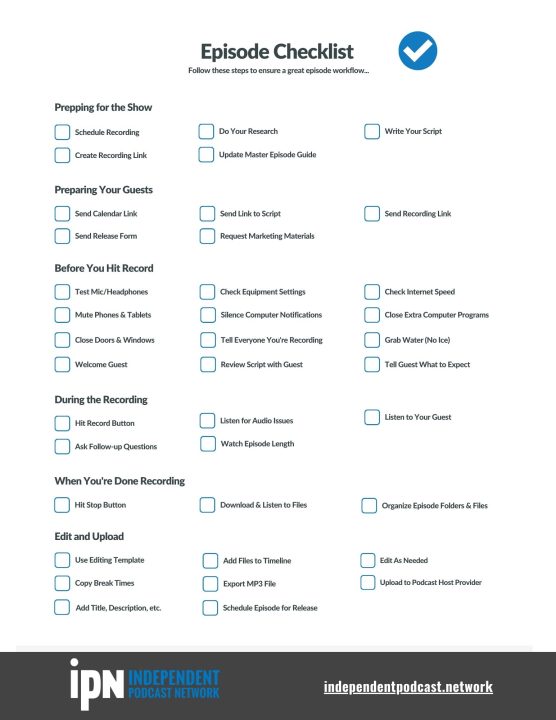
Episode Transcript
0:01
Even if you’re not a numbers person, knowing your podcast stats and analytics is an important part in your whole production process. If you know who’s listening and what they’re listening to, then you can create more content that they like, and potentially grow your podcast audience. And if you’re planning to work with partners or advertisers, they’ll also want to know how many people are listening and how often. So how do you know which metrics to track and how often today we’re talking about measuring your podcast stats, and analytics? Take it away, Mister radio man. Podcast Your Business.
0:47
Hey, everybody, welcome to Podcast Your Business. My name is Sunny Gault. I’m a podcast coach. I’m a mentor, and I’ve been podcasting for 17 years. I’m also the founder and CEO of Independent Podcast Network, please check us out. The website is https://independentpodcast.network, we’ve got a ton of amazing free content on the website. And if you’re ready to monetize, we’d love to help you out with that as well. But today, I am here to help you create amazing podcasts. And we like to focus more on podcasting for your business. I think today’s topic is going to be a little bit more general, though. But this is how we do it. We go through and we talk about something called the five P’s of podcasting, right, the five P’s. So you’re probably thinking what in the world are the five P’s here we go, prep plan and produce, promote and profit. As I’ve said, I have been podcasting for a really long time. And I found these are the five P’s that you really need to know, in order to have a successful podcast. So we start with prep, and we think about, Well, should I even start a podcast? What are some of the initial questions you should be asking yourself and and how should you prep for the possibility of having a podcast? And then planning is about actually, you know, thinking about your show? What do you want it to look like? What should the feel of it be? How often should you release episodes, all that good stuff? Produce is actually creating the content? Right? Should you have an audio podcast, a video podcast? What microphone should you use? What other equipment do you need? Promote is just telling everyone about it, because you could have the most amazing podcasts in the world. But if nobody knows, it’s kind of like it doesn’t exist, right. And then finally, profit, because we want you making money with your show. We want it to tie back into your business. So hopefully, it’s helping your business if you do have a show that is related to the focus of your business. And if not, we talk a lot about just advertising and ways to work in advertising and make it work for your podcast.
2:56
Mr. radio man, what are we talking about today? Plan? Yeah, you know, truth be told, it was tough to put together today’s topic and put it into one of these peas. But I went with plan because the information that you learn through your podcast stats and analytics, well, that’s going to help you plan for the future of your podcast, whether you’re planning for your content, or you’re planning what brands and advertisers you want to work with. So that’s why we’re focused on plan today. But let me kind of give you the rundown of what we’re going to discuss. In today’s episode, we are going to talk about why podcast stats are sometimes a challenge to track. And I don’t want to be Debbie Downer with this. But podcasting is not really known for being forthcoming with stats, and they’ve made it a little challenging for podcasters. So we’re going to talk about that. We’ll also review the most important podcast stats to to monitor and to consider. This, of course, is just based on my years of experience. And I’m also going to share a couple with you that are kind of misnomers, ones that people focus on. And it really doesn’t mean anything. So I’m just gonna give you my two cents on all of that. We’re going to explain how to find these stats. And there are some additional tools and little tips and tricks that I’ve learned in the past that can help you so I’ll share that. And then we’ll talk briefly about some ways you can use this podcast data and we’ll talk about that throughout the entire episode, right because what’s the use of having any of these stats if you don’t know what to do with them? All right, we’re gonna get started right after this quick break.
4:35
So I have a bit of a confession to make. I am not a numbers person. So reviewing podcast data is not super fun for me. You know some people love pie charts, those graphs the spreadsheets, yeah, that is not my jam. still reviewing podcast data and your stats. This is something you need to do it so you can track the success of your show. That’s really important, right. And you also want to be able to sound intelligent, if you get to the point where you can work with podcast advertisers. Because if you don’t know your stats for that, forget it, you’re never going to close the sale. I promise you that. So let’s go ahead and dive into this. First thing I want to talk about is it’s kind of the elephant in the room. If you’ve been podcasting for any length of time, you’ve probably already realized this, and that is that podcast stats are kind of hard to track. And I’ve been thinking about why that is in preparation for today’s episode. And I’m going to share some of my thoughts with you. First of all, we talked about downloading episodes, if you are going to physically download an episode. So maybe you’re on your podcast app, you click download, whatever, the moment, someone downloads an episode, you lose control of knowing what they’re doing with that episode, because they could listen to it a million times, but you have no way of tracking that like on their computer or on their phone. So you just lose control with actual downloads. And that’s why there is a much bigger push right now for streaming, we want people to stream things. So we can track exactly what they’re doing. It’s a little bit like Big Brother, I know it’s a little freaky when you really think about it. But it does help podcasters to know what people are doing with the content that they’re creating. Now, streaming is much better for getting stats for the podcaster. But it’s not the best experience for listeners. Because I think one of the beauty of podcasts is that you can listen to it anywhere. And there are still plenty of places in the world. For example, tomorrow, I’m hopping on a plane, and on the plane, unless I want to spend a lot of money for their internet, I am not going to be able to listen to anything on a streaming platform. So a lot of times, if I want to listen to a podcast, I will download it in advance. But then, you know, again, from the podcast point of view, once I download it, you’re not gonna get any of those stats. So that’s one of the reasons it’s kind of hard to track what’s going on with your podcast in terms of stats, because a lot of people are still downloading the content.
7:19
The other thing is that there’s not just one authority to capture all of your stats. So for example, I’m not a blogger per se. But if I was, or if I, you know, had a website that was a destination site, then I would be running all of that through Google Analytics. Google Analytics is kind of the standard when it comes to websites. And then your blog is usually on your website. And then when it comes to video, so if I am just you know all about videos, usually that’s YouTube, or perhaps another provider, but you know, you get your stats from these big sources, right, and you get everything in one place. And that is not the case with podcasting. Now, in all fairness, we do have what I call the Big Three, which are the top destination sites where people consume podcasts. So that would be Apple Podcasts, Spotify, Google Podcasts, but they even make it tricky. Because there’s always restrictions. So if you’re a podcaster, and you want to put your content on these sites, you create some sort of an account with them, okay, and you connect your podcast. And then if you want to see stats through these resources, and sometimes they do have some really interesting stats, by the way, but there’s always restrictions or limitations as to what stats you’re actually getting. So for example, for Apple podcasts, if we were to sign into your account, you would, you know, see some interesting stats, but at the same time, it’s all based on what version of what device they’re using. And if it goes too far back, they don’t even count it. Right. And then, you know, with Spotify, it’s listening on their device with Google podcasts. It’s listening through some sort of, you know, the Google app or through the desktop version. And I think one of the amazing things about podcasts is that there’s all these different ways to listen to the podcast. So it’s a bit of a challenge, when the sites aren’t really helping you. It’s only showing you kind of have a limited view of what your audience is doing.
9:35
So that means what we have to do is we have to go back to our home base. Now all all podcasts are based on RSS feeds, we all have an RSS feed that’s associated with our podcast. And our podcast host provider gives us that RSS feeds so really your podcast host provider is your home base for your podcast. That’s where you upload your episodes and because you upload your content there. And because they provide you with your RSS feed that goes out to all these other distribution sites. Well, that’s the best place really to get stats for how your podcast is doing. And wouldn’t it be nice if they all provided the same stats, but they don’t. Now, there are some common denominators. But one thing, especially if you go down the advertising route with your show, a stat that you’re really going to need are the demographics for your podcast. So this is the age of the people listening, their gender, their income, their education, right, because we want to know what types of products or services are best for your demographic. And that has been ridiculously difficult for podcast host providers to provide I am not sure why. But if I put on my little conspiracy hat, I would say it’s probably related to money, they are probably making more money, not giving you that information, then giving you that information. So we’ll just kind of leave it at that. But just know that if you do have a podcast host provider that provides those demographics, because there are a few congratulations, because the vast majority of them do not. In fact, for a while podcasters just started using the stats, the demographics, from social media, and YouTube, because you can get stats from those. So if they had a channel on YouTube, or they had social media sites, they would just use that and their media kit to say, Hey, these are the you know, this is the demographic for my podcast, it’s a little cheating. It’s a little bit like cheating with that, because it’s skewed towards whatever platform you’re pulling those stats from. Okay, so if social media, let’s just say that’s a younger crowd, then it’s going to show younger demographics simply because you’re pulling those stats from social media. So it’s not the best thing to do. I realize that’s what a lot of podcasters have been doing over the years. But what we really need are those demographics that I know the podcast host providers have. And for whatever reason, they are just not very forthcoming and sharing it. So I just wanted to get the elephant out of the room here, before we dive in, and really talk about what stats you can get, and how to get them.
12:28
So let’s talk about the most important stats that you should be monitoring. Okay. When we think in terms of your podcast, we have to think about downloads, which isn’t always a true download, if you hear the word stream or impression, kind of the same thing. Now, from my perspective, what you really need to be focused on when it comes to downloads and impressions, there’s two things, what are your average monthly downloads? Okay, for all of your podcasts, like all the episodes within your podcast, so how many times for the entire month? Is your show, you know, downloaded? Do you have impressions for streaming? All that good stuff? So what are the average monthly impressions? And then the second is, what is the average per episode? Now this can get kind of tricky to figure out because once you publish an episode, it’s always out there. So Where’s where’s the cut off? Right? Usually, it’s within a 30 day period from release. Okay, so count out from when you release the podcast episode 30 days, and how many downloads within 30 days? Does that episode get the next stat that I think is important, and I don’t see this in a lot of places, but maybe your podcast host provider provides it. It’s the percent difference or change and downloads or impressions over the last 30 days for your show. So this is what you’ll see. You’ll log into your account, and you’ll see, you know, the total amount of downloads for you know, whatever, the last 30 days, okay, and then there’ll be like a smaller number next to it in parentheses, and then it’ll say maybe, like plus 5%, or negative 10%. And what that is telling you is that it is basically comparing the last 30 days from the previous 30 days. So are you up 5%? Are you down, 10%? And I’d like to see that because that’s just a quick snapshot for me to know kind of how I’m doing, how am I doing month over month. It’s just something that I like to look at. So I found that to be very helpful. Sometimes podcast host providers have it, sometimes they don’t.
14:50
Another popular one is the average time listened. So when someone is listening to your episode, how long do they listen to before they get out all before they go on to the next podcast, right? Because the tricky thing is, is that when you’re looking at downloads, sometimes people could only be listening for a few minutes, and then they’re gone. Right? So does that count is a download? I mean, yeah, it usually does. But it’s not. It’s not very true, right? Because when we think of a download, we think, Oh, someone listen to the whole episode, and rarely is that the case. So when you look, at average time, listen, it really does shed some light on how the entire episode is doing. So usually, like if you log into Apple Podcasts, I think Google Podcasts has this as well. And I hardly ever log into Spotify. But Spotify may have it too. So you can pull up individual episodes, and it kind of has like a line chart, and look for the dips, because where it dips is where people are leaving, or if it dips and comes back up there fast forwarding. So you know, if all the dips are where your commercial breaks are, that may not be a very good thing, you may need to change up your commercial breaks. Or if you find out that everyone is dropping off after about five minutes, maybe you’re not getting to the content that you promised them your actual topic for your show fast enough, maybe there’s too much chitchat. So again, that’s called average time listened. And usually it’s not podcast host providers that have that it’s usually the streaming services, the Apple Podcasts, the Google Podcasts that you can look that up.
16:41
So let’s talk about unique listeners. Sometimes, I feel like this is more of like a, a website, you know, terminology, but we’re starting to pick it up more in podcasting. So we want to know the actual amount of listeners and not just the total amount of downloads, because someone could listen to multiple episodes for your podcast. That’s kind of what you want. But sometimes people want to know, well, what are the actual amount of people you know, that are that are listening, not just all the stuff that they’re listening to. So that’s unique listens, and that can be helpful as well. Also listener location, podcasting breaks that down according to country according to state, and then according to select cities, so it’s not like you can look up any state in the world and find out what your listenership is, it is, and I’m not even sure how they figure this out, they figured out what are the most important cities, and maybe it’s based on sales, I have no idea. But it will basically just, you know, it’ll list out all the cities, and then it’ll tell you how many listeners from each city or each location. And that can be helpful too, especially, you know, if you are doing content that is location specific. Or if you have an advertiser that only wants to advertise in a certain location, they may want to know what your download numbers are in, let’s say New York City. So that’s helpful as well.
18:07
Now, a couple of misleading stats. This is like, some things just kind of irked me. So I’m gonna go through two stats, that really, really irked me. And the first is total amount of downloads in the history of your podcast. Okay? So let’s just be honest here, that is a vanity stat. Because nobody is ever going to ask you your total amount of downloads ever for your podcast, because it’s completely irrelevant, except to pat yourself on the back, which I will admit, can be very helpful, especially if you see those numbers really start to climb up. But that is just for you. advertisers don’t care at all. And if you end up switching your podcast host provider, your stats don’t come with you. And that’s a question I get all the time is oh my gosh, I don’t have my total number of downloads ever. And I’m like, it really doesn’t matter. It doesn’t matter. Okay, that’s a vanity stat. So that’s, that’s a little bit of a pet peeve of mine. The other one is sometimes you’ll see podcast host providers provide the most popular time of day people are listening to your podcast. That sounds good on one hand, because you’re like, oh, a lot of people are listening at this time. So I’ll release my episodes that this time, but it’s very misleading. Because usually the amount of time that is going to be the strongest is when you selected to release the episode. So it’s not necessarily that that’s when everybody is listening. That’s just when you chose to release it and depending on the player, it may automatically download it the moment a new episode comes out, so I don’t look at that either. I released my episode When I want to release my episodes, it’s usually at 12am. Just because, you know, I’m starting at the beginning of the day, so to speak, I think that the day is more important than the time of day. So when you see that stat, I don’t know, my advice is just maybe look at it, but know that there are other factors going into that information.
20:22
Okay. Let’s talk about how do you get these stats? Okay, because we talked earlier about sometimes it’s hard for podcasters to get these stats. So what’s my recommendation? first focus on the stats provided by your podcast host provider, get a reputable podcast host provider, a lot of times, these free ones are not going to give you the stats that you need. And you do need to look at the stats, even if you’re not a numbers person. So upgrade your plan, change your podcast host provider if they’re not going to give you anything, because stats are really important to know what to do with your show. Okay, so focus on your podcast host provider. Next, there are some third party services out there that can help fill in the gaps. One that I use is called Chartable and its Chartable Pro. So there’s a free version of it. And then Chartable Pro is the paid version. I talk about Megaphone a lot on this podcast, that’s our podcast host provider. That’s the one I recommend. If you have an account with Megaphone, Chartable Pro is automatically added to it because they’re both owned by Spotify. Okay. But with Chartable Pro, you actually you put this little prefix on your RSS feed real easy to do and outsell it sounds techie, but it’s not. And then it will give you those demographics that I was talking about earlier. Okay. So the age and, you know, education and how much money they make stuff like that gender, right? Those things that are really hard to get, it will include that, for whatever podcasts have this little prefix on it. It also gives the geographics. It also lists podcast players like how are people like what devices are people listening on, I don’t find that to be super duper helpful. Maybe you just want to geek out on that that’s fine, too. But all of that’s Chartable Pro.
22:23
Another thing that I’ve done, this worked really, really well. And it probably depends on how big your audience is. But I reached out to my audience, and I provided a questionnaire. And it had, you know, maybe 10 questions or so. And then I made it eligible if they filled out the questionnaire to get $100 gift card to Amazon, or you know, pick whatever place you want. But that worked out really well. And I found out a lot of information about my audience. So maybe consider something like that. In general, I think the best piece of advice that I can give you guys is, please don’t stress out about your stats. These are tools, these are resources. But please understand your podcast stats do not define the success of your podcast. Okay, it’s about helping people. It’s about reaching people in a new way and starting conversations. And that’s what really matters. We’ll be right back after this quick break.
23:26
As always, I do have a free handout for you guys today. And I know we’ve been talking about stats and your brain probably hurts. And now you’re thinking… great Sunny. I can’t even remember how to do my podcast. Because I’ve got all this stat and analytics information in my head. Well, that happens to be you, you’re gonna appreciate today’s handout. It is an episode guide and episode checklist. And it takes you through all the steps all the things that I have in my head as I go through my little checklist, I can check everything off as I’m doing an episode as I’m publishing an episode just to make sure they do everything I need to do. Also, we have made a bunch of changes to our website, https://independentpodcast.network. So if you haven’t been to the site, please go there. There’s a ton of free resources. All of these podcast episodes are there. We have new blog posts that go out every week. There’s videos. In fact, I’m working on a brand new course that’s all about advertising and dynamic ad insertion. There’s a ton of handouts. Other courses are on the side as well. So this is my gift to you guys. All the content is free. You don’t even have to give me your email address. It’s just on the website and you can download the handouts as well. So check us out https://independentpodcast.network. Until next week, remember you should start a podcast!
